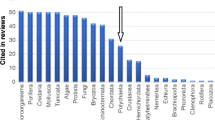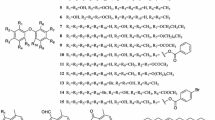Abstract
Extracts of the dorid nudibranch Asteronotus cespitosus from two geographically separate regions of Australia and from the Philippines were compared using thin-layer, high-performance liquid and gas chromatography and 1H NMR analysis. Halogenated metabolites were detected in all mollusk specimens. The major component detected in digestive tissue of specimens from the Great Barrier Reef in northeastern Australia was 4,6-dibromo-2-(2′,4′-dibromophenoxy)phenol (1), with minor amounts of 3,5-dibromo-2-(3′,5′-dibromo-2′-methoxyphenoxy)phenol (2). In a specimen collected from northwestern Australia, only 3,5-dibromo-2-(3′,5′-dibromo-2′-methoxyphenoxy)phenol was found. The specimen from the Philippines contained 2,3,4,5-tetrabromo-6-(2′-bromophenoxy)phenol (3) together with a novel chlorinated pyrrolidone (4). In addition, the sesquiterpenes dehydroherbadysidolide (5) and spirodysin (6) were detected in the digestive organs and mantle tissue of the nudibranchs from the Great Barrier Reef and from the Philippines, whereas these chemicals were not found in the specimen from northwestern Australia. All of the chemicals (1-3,5, and 6) have previously been isolated from the sponge Dysidea herbacea, as have chlorinated metabolites related to 4. This is the first time the characteristic halogenated metabolites that typify Dysidea herbacea have been reported from a carnivorous mollusk, which implies a dietary origin as opposed to de novo synthesis.
Similar content being viewed by others
REFERENCES
Avila, C. 1995. Natural products of opisthobranch mollusks: a biological review. Ocean. Mar. Biol. Annu. Rev. 33:487–559.
Avila, C., Cimino, G., Crispino, A., and Spinella, A. 1990. Drimane sesquiterpenoids in Mediterranean Dendrodoris nudibranchs: anatomical distribution and biological role. Experientia 47:306–310.
Brunckhorst, D. J. 1993. The systematics and phylogeny of phyllidiid nudibranchs (Doridoidea). Rec. Aust. Mus. Suppl.16:1–107.
Cameron, G. M., Stapleton, B. L., Simonsen, S. M., Brecknell, D. J., and Garson, M. J.2000. New sesquiterpene and brominated metabolites from the tropical marine sponge Dysidea sp. Tetrahedron 56:5247–5252.
Capon, R., Ghisalberti, E. L., Jefferies, P. R., Skelton, B.W., and White, A. H. 1981. Structural studies of halogenated diphenyl ethers from a marine sponge. J. Chem. Soc. Perkins Trans. 1:2464–2467.
CartÉ, B. and Faulkner, D. J. 1981. Polybrominated diphenyl ethers from Dysidea herbacea, Dysidea chlorea and Phyllospongia foliascens. Tetrahedron 37:2335–2339.
Cimino, G. and Ghiselin, M. T. 1998. Chemical defense and evolution in the Sacoglossa (Mollusca: Gastropoda: Opisthobranchia). Chemoecology 8:51–60.
Cimino, G. and Ghiselin, M. T. 1999. Chemical defense and evolutionary trends in biosynthetic capacity among dorid nudibranchs (Mollusca: Gastropoda: Opisthobranchia). Chemoecology 9:187–207.
Cimino, G. and Sodano, G. 1994. Transfer of sponge secondary metabolites to predators, Sponges in Time and Space. Balkema, in v. K. B. van Soest (ed.), Rotterdam. pp. 459–472.
Cimino, C., De Rosa, S., De Stefano, S., and Sodano, G. 1985. Observations on the toxicity and metabolic relationships of polygodial, the chemical defense of the nudibranch Dendrodoris limbata. Experientia41:1335–1336.
Cimino, G., Fontana, A., and Gavagnin, M. 1999. Marine opisthobranch molluscs: chemistry and ecology in sacoglossans and dorids. Curr. Org. Chem. 3:327–372.
Dumdei, E. J., Kubanek, J., Coleman, J. E., Pika, J., Andersen, R. J., Steiner, J. R., and Clardy, J. 1997a. New terpenoid metabolites from the skin extracts, an egg mass, and dietary sponges of the Northeastern Pacific dorid nudibranch Cadlina luteomarginata. Can. J. Chem. 75:773–789.
Dumdei, E. J., Simpson, J. C., Garson, M. J., Byriel, K. A., and Kennard, C. H. 1997b. New chlorinated metabolites from the tropical marine sponge Dysidea herbacea. Aust. J. Chem. 50:139–144.
Fahey, S. J. and Gosliner, T.M. 2001. The Phylogeny of Halgerda (Opisthobranchia, Nudibranchia) with the description of a new species from Okinawa. Zool. Scripta 30:199–213. 1784 FAHEY AND GARSON
Faulkner, D. J. and Ghiselin, M. T. 1983. Chemical defense and evolutionary ecology of dorid nudibranchs and some other opisthobranch gastropods. Mar. Ecol. Prog. Ser. 13:295–301.
Faulkner, D. J., Molinski, T. F., Andersen, R. J., Dumdei, E. J., and De Silva, E. D. 1990. Geographical variation in defensive chemicals from Pacific coast dorid nudibranchs and some related marine mollusks. Comp. Biochem. Physiol. 97C:233–240.
Fontana, A., Avila, C., Martinez, E., Ortea, J., Trivellone, E., and Cimino, G. 1993. Defensive allomones in three species of Hypselodoris (Gastropoda: Nudibranchia) from the Cantabrian Sea. J. Chem. Ecol.19:339–355.
Fontana, A., Gimenez, F., Marin, A., Mollo, E., and Cimino, G. 1994. Transfer of secondary metabolites from the sponges Dysidea fragilis and Pleraplysilla spinifera to the mantle dermal formations (MDFs) of the nudibranch Hypserlodoris [Hypselodoris] webbi. Experientia 50:510–516.
Fontana, A., Ciavatta, M. L., Miyamoto, T., Spinella, A., and Cimino, G. 1999. Biosynthesis of drimane terpenoids in dorid molluscs: pivotal role of 7-deacetoxyolepupuane in two species of Dendrodoris nudibranchs. Tetrahedron 55:5937–5946.
Fu, X., Schmitz, F. J., Govindan, M., and Abbas, S. A. 1995. Enzyme inhibitors: New and known polybrominated phenols and diphenyl ethers from four Indo-Pacific Dysidea sponges. J. Nat. Prod. 58:1384–1391.
Gavagnin, M., Mollo, E., Calado, G., Fahey, S., Ghiselin, M., Ortea, J., and Cimino, G. 2001. Chemical studies of porostome nudibranchs: comparative and evolutionary aspects. Chemoecology 11:131–136.
Graziani, E. I., Andersen, R. J., Krug, P. J., and Faulkner, D. J. 1996. Stable isotope incorporation evidence for the de novo biosynthesis of terpenoic acid glycerides by dorid nudibranchs. Tetrahedron 52:6869–6878.
Handayani, D., Edrada, R. A., Proksch, P., Wray, V., Witte, L., VanSoest, R.W.M., Kunzmann, A., and Soedarsono. 1997. Four new bioactive polybrominated diphenyl ethers of the sponge Dysidea herbacea from West Sumatra, Indonesia. J. Nat. Prod. 60:1313–1316.
Harrigan, G. G., Luesch, H., Moore, R. E., and Paul, V. J. 2000. The anticancer dolastatins as cyanobacterial metabolites, in S. K. Wrigley, M. A. Hayes, R. Thomas, E. J. T. Chrystal and N. Nicholson (eds.), Biodiversity: NewLeads for the Pharmaceutical and Agrochemical Industries. Royal Society of Chemistry, London. pp. 126–139.
Hellou, J. and Andersen, R. J. 1982. Terpenoids from the dorid nudibranch Cadlina luteomarginata. Tetrahedron38:1875–1879.
Hofheinz, W. and OberhÄansli, W. E. 1977. Dysidin; a novel chlorine-containing natural product from the sponge Dysidea herbacea. Helv. Chim. Acta 60:660–669.
Kazlauskas, R., Murphy, P. T., and Wells, R. J. 1978.A new sesquiterpene from the sponge Dysidea herbacea. Tetrahedron Lett. 49:4949–4950.
Krug, P. J., Boyd, K. G., and Faulkner, D. J. 1995. Isolation and synthesis of tanyolides A and B, metabolites of the nudibranch Sclerodoris tanya. Tetrahedron 51:11063–11074.
Kubanek, J. M., Faulkner, D. J., and Andersen, R. J. 2000. Geographic variation and tissue distribution of endogenous terpenoids in the northeastern Pacific Ocean dorid nudibranch Cadlina luteomarginata: implications for the regulation of de novo biosynthesis. J. Chem. Ecol. 26:377–389.
Kuniyoshi, M., Yamada, K., and Higa, T. 1985. A biologically active diphenyl ether from the green alga Cladophora fascinularis. Experientia 41:523–524.
Marin, A., Belluga, M.D. L., Scognamiglio, G., and Cimino, G. 1997. Morphological and chemical camouflage of the Mediterranean nudibranch Discodoris indecora on the sponges Ircinia variabilis and Ircinia fasciculata. J. Mollusc Stud. 3:431–439.
Marin, A., LÓpez, M. D., Esteban, M. A., Meseguer, J., MuÑoz, J., and Fontana, A. 1998. Anatomical and ultrastructural studies of chemical defence in the sponge Dysidea fragilis. Mar. Biol. 131:639–645.
Norton, R. S., Croft, K. D., and Wells, R. J. 1981. Polybrominated oxydiphenol derivatives from the sponge Dysidea herbacea. Tetrahedron 37:2341–2349.
Pennings, S. C., Pablo, S. R., Paul, V. J., and Duffy, J. E. 1994. Effects of sponge secondary metabolites in different diets on feeding by three groups of consumers. J. Exp. Mar. Biol. Ecol. 180:137–149.
Pennings, S. C., Paul, V. J., Dunbar, D. C., Hamann, M. T., Lumbang, W. A., Novack, B., and Jacobs, R. S. 1999. Unpalatable compounds in the marine gastropod Dolabella auricularia: Distribution and effect of diet. J. Chem. Ecol. 25:735–755.
Salva, J. and Faulkner, D. J. 1990. A new brominated diphenyl ether from a Philippine Dysidea species. J. Nat. Prod. 53:757–760.
Schulte, G. R., Schever, P. J., and McConnell, O. 1980. Two furanosesquiterpene marine metabolites with antifeedant properties. Helvetica Chimica Acta 63:2159–2167.
Sera, Y., Adachi, K., Nishida, F., and Shizuri, Y. 1999. A new sesquiterpene as an antifouling substance from a Palauan marine sponge, Dysidea herbacea. J. Nat. Prod. 62:395–395.
Slattery, M., Avila, C., Starmer, J., and Paul, V. J. 1998. A sequestered soft coral diterpene in the aeolid nudibranch Phyllodesmium guamensis Avila, Ballesteros, Slattery, Starmer and Paul. J. Exp. Mar. Biol. Ecol. 226:33–49.
Stapleton, B. L., Cameron, G. M., and Garson, M. J. 2001. New chlorinated peptides from the tropical marine sponge Dysidea sp. Tetrahedron 57:4603–4607.
Thompson, J. E., Walker, R. P., Wratten, S. J., and Faulkner, D. J. 1982. A chemical defense mechanism for the nudibranch Cadlina luteomarginata. Tetrahedron 38:1865–1873.
Unson, M. D. 1993. Chemical and Biological Studies of the Symbiosis Between a Marine Sponge and a Cyanobacterium. University of California, San Diego, California, 180 pp.
Unson, M. D., Rose, C. B., Faulkner, D. J., Brinen, L. S., Steiner, J. R., and Clardy, J. 1993. New polychlorinated amino acid derivatives from the marine sponge Dysidea herbacea. J. Org. Chem. 58:6336–6343.
ValdÉs, A. A phylogenetic analysis and systematic revision of the cryptobranch dorids (Mollusca, Nudibranchia, Anthobranchia). Zool. J. Linn. Soc. London. In press.
ValdÉs, A. and Gosliner, T.M. 1999. Phylogeny of the radula-less dorids (Molllusca, Nudibranchia), with the descriptions of a new genus and a new family. Zool. Scripta 28:315–360.
Author information
Authors and Affiliations
Corresponding author
Rights and permissions
About this article
Cite this article
Fahey, S.J., Garson, M.J. Geographic Variation of Natural Products of Tropical Nudibranch Asteronotus cespitosus . J Chem Ecol 28, 1773–1785 (2002). https://doi.org/10.1023/A:1020509117545
Issue Date:
DOI: https://doi.org/10.1023/A:1020509117545




